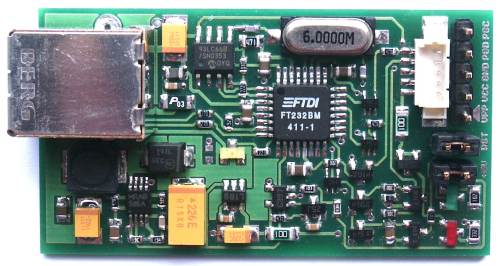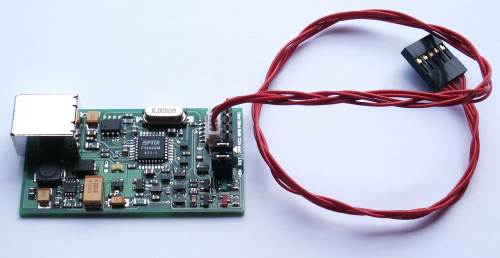In need of a programmer for PIC micro controllers I decided to build my own one. This programmer has been designated as "PIC JDM Prototype Programmer 1001" because it is very likely the 1001st PIC programmer :-)
The programmer is basically operating as a JDM-programmer. Any programming software that is compatible with JDM hardware might be used for programming. The major advantage over typical JDM programmers is that it connects to the programming host via USB and not via an RS232 interface. USB has the advantage that it delivers regular power along with data transmission. Though, existing programmers show that the power can be taken with some tricks from the RS232, but I do not like that...
Another advantage of a USB connection is that most new notebook computers do not provide an RS232 interface any longer.
This programmer is specifically designed for in-system programming, or "In-Circuit Serial Programming" (ICSP) as it is designated by Microchip. I.e. the PIC to be programmed is already soldered into the target system.
The programming voltage (approx. 13V) is generated using a small switching regulator circuitry. Some other circuitry is needed for programming voltage switching etc.
PGD and PGC
Application VCC < 5V
Meanwhile, the reason for this slow speed has been figured out. Unfortunately, it is not a driver or configuration problem as initially suspected. Rather it is an inherent "feature" of USB. The problem is that the nature of USB introduces latencies of at least 1ms. Because the JDM programmer's serial data transmission is based on switching the RS232 signals RTS and DTR, each toggling of these lines requires one USB transaction. And every USB transaction brings along a delay of at least 1ms (in practice, I measured around 1.4ms in best case). In order to get an idea about the relations, the same operation with a natural UART on the same machine takes just 2 micro seconds - that is 700 times faster.
The only solution to fight with this issue is to off-load the actual programming task to a small external micro controller that is controlled via USB. As one example, some Programmers of Tony Nixon (see here) show how this can be done. Although there is nothing written about programming times, the speed should be quite high. Though, it won't be possible to use well-proven existing programming software such as Picprog or IC-Prog. But on the other hand, programming these micro controllers is not that complicated.

This is a perspective view including an attached programming cable.

The programmer is basically operating as a JDM-programmer. Any programming software that is compatible with JDM hardware might be used for programming. The major advantage over typical JDM programmers is that it connects to the programming host via USB and not via an RS232 interface. USB has the advantage that it delivers regular power along with data transmission. Though, existing programmers show that the power can be taken with some tricks from the RS232, but I do not like that...
Another advantage of a USB connection is that most new notebook computers do not provide an RS232 interface any longer.
This programmer is specifically designed for in-system programming, or "In-Circuit Serial Programming" (ICSP) as it is designated by Microchip. I.e. the PIC to be programmed is already soldered into the target system.
Features
- 5-wire programming interface:
MCLR/VPP (programming voltage)
VCC (regular +5V supply voltage)
GND (ground)
PGD (programming data)
PGC (programming clock)
All these wires are to be directly connected to the PIC to be programmed. - There is no additional supply voltage required. The PIC programming voltage (around 13V) is generated on-board using a small switching regulator.
- 5V power supply voltage can be delivered by the programmer or by the target system itself. There is a jumper used to determine whether the programmer feeds the +5V or not. There is no contention when +5V is provided by both the programmer and the target system.
- A (green) LED signals whether the PIC supply voltage is around +5V.
- A (red) LED indicates whether the PIC programming is in progress.
- A second jumper can be used to keep the PIC in a reset-state when it is not being programmed. This is important when the PIC to be programmed is normally used with a low-voltage supply (e.g. 3.3V). As the PIC needs to be programmed at VCC=+5V which is normally supplied by the programmer, the PIC would start executing code at +5V immediately after VPP is removed. As a result, some IO-pins might be programmed to output a high-level (i.e. 5V in this moment). This could hurt other circuitry attached to the micro controller when it does not have 5V-tolerant inputs.
- Although it is not a feature: Following the Microchip terminology, the programmer is designated as prototype programmer. This is because the PIC is verified at VDD=+5V instead of +2V as suggested by Microchip.
It would not be a big deal to include such a VDD switching. However, the RS232-based JDM programmer cannot support this feature due to lack of control lines. As a result, most of the existing PIC programming software does not support this as well.
Nevertheless, the programming procedure is working flawlessly so far.
Operational Principle
The core component is an USB<->Serial converter chip (FT232BM) fromFTDI. The according driver provides a serial interface functionality and makes the USB connection transparent. This allows the use of existing programming software without any modification.The programming voltage (approx. 13V) is generated using a small switching regulator circuitry. Some other circuitry is needed for programming voltage switching etc.
Requirements for the Target System
A few precautions need to be taken in order to guarantee a flawless operation of the target system itself as well as its interoperation with the programmer.PGD and PGC
- As long as those pins of the PIC are not used by the target application there is nothing to take care for. In the other case the designer needs to be aware that those lines will carry 5V levels during programming. Also it has to be ensured that both lines are not actively driven by other circuitry during programming.
- When the target system is operating at 5V, there are no special precautions necessary. In this case the target system should be powered by itself during programming. I.e. the jumper used to provide power from the programmer should not be set. When the whole application draws only a few mA it might be safely powered from the programmer.
Application VCC < 5V
- When the target system is operating at a lower voltage some further considerations are required. When the application is completely 5V tolerant (including the output of the voltage regulator) and it draws only a few mA it can be easily supplied by the programmer with 5V. When this is not the case, the supply voltage of the PIC needs to be isolated from the remaining application circuitry. This can be done via a small Schottky diode, when the voltage drop can be tolerated. Another solution would be the use of a jumper used for isolating VDD of the PIC from the rest of the system.
- Due to the 13V, MCLR/VPP has to be isolated from the remaining system in any case. This can be done by a small Schottky diode which isolates the typical R-C power-on-reset circuitry. This avoids the propagation of the 13V programming voltage into the power supply rail of the application circuit.
Programming Software
As described above, virtually any JDM programmer software can be used. I have successfully used Picprog (Rev. 1.7) under Linux. IC-Prog is working fine as well under Windows XP.Supported PIC Devices
Provided the used programming software does support the chip, all Flash-based PICs should be supported by the programmer. Until now, this device has been used successfully with PIC16F73, PIC16LF74, and PIC16LF77.Known Odds
The only problem that appeared so far is a rather slow programming speed. While the programming of some test-system with a certain test-code and a native RS232 interface took just a fraction of a second, it took around 2 minutes when using the USB-controlled programmer. Under Windows (using IC-Prog) the situation is even more worse.Meanwhile, the reason for this slow speed has been figured out. Unfortunately, it is not a driver or configuration problem as initially suspected. Rather it is an inherent "feature" of USB. The problem is that the nature of USB introduces latencies of at least 1ms. Because the JDM programmer's serial data transmission is based on switching the RS232 signals RTS and DTR, each toggling of these lines requires one USB transaction. And every USB transaction brings along a delay of at least 1ms (in practice, I measured around 1.4ms in best case). In order to get an idea about the relations, the same operation with a natural UART on the same machine takes just 2 micro seconds - that is 700 times faster.
The only solution to fight with this issue is to off-load the actual programming task to a small external micro controller that is controlled via USB. As one example, some Programmers of Tony Nixon (see here) show how this can be done. Although there is nothing written about programming times, the speed should be quite high. Though, it won't be possible to use well-proven existing programming software such as Picprog or IC-Prog. But on the other hand, programming these micro controllers is not that complicated.
Pictures
The board has all components mounted on the top side. The bottom side is empty and contains mostly a big ground plane.
This is a perspective view including an attached programming cable.
